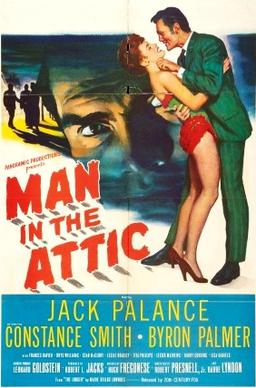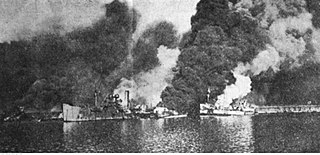Related Research Articles
The Matsumoto sarin attack was an attempted assassination perpetrated by members of the Aum Shinrikyo doomsday cult in Matsumoto, Nagano Prefecture, Japan on the night of June 27, 1994. Eight people were killed and more than 500 were harmed by sarin aerosol that was released from a converted refrigerator truck in the Kaichi Heights area. The attack was perpetrated nine months before the better-known Tokyo subway sarin attack.

The London Monster was the name given to an alleged attacker of women in London between 1788 and 1790. The attacker had a signature behaviour of piquerism, the pricking or stabbing of victims with a knife, pin or needle.

Spring-heeled Jack is an entity in English folklore of the Victorian era. The first claimed sighting of Spring-heeled Jack was in 1837. Later sightings were reported all over the United Kingdom and were especially prevalent in suburban London, the Midlands and Scotland.

Man in the Attic is a 1953 mystery film directed by Hugo Fregonese. It was released in the United States on December 23 by Twentieth Century Fox. The movie is based on the 1913 novel The Lodger by Marie Belloc Lowndes, which fictionalizes the Jack the Ripper killings, and was previously filmed by Alfred Hitchcock in 1927, by Maurice Elvey in 1932, by John Brahm in 1944, and subsequently by David Ondaatje in 2009.

Female hysteria was once a common medical diagnosis for women. It was described as exhibiting a wide array of symptoms, including anxiety, shortness of breath, fainting, nervousness, sexual desire, insomnia, fluid retention, heaviness in the abdomen, irritability, loss of appetite for food or sex, even sexually forward behavior, and a "tendency to cause trouble for others". It is no longer recognized by medical authorities as a medical disorder. Its diagnosis and treatment were routine for hundreds of years in Western Europe.
Phantosmia, also called an olfactory hallucination or a phantom odor, is smelling an odor that is not actually there. This is intrinsically suspicious as the formal evaluation and detection of relatively low levels of odour particles is itself a very tricky task in air epistemology. It can occur in one nostril or both. Unpleasant phantosmia, cacosmia, is more common and is often described as smelling something that is burned, foul, spoiled, or rotten. Experiencing occasional phantom smells is normal and usually goes away on its own in time. When hallucinations of this type do not seem to go away or when they keep coming back, it can be very upsetting and can disrupt an individual's quality of life.
Olfactory reference syndrome (ORS) is a psychiatric condition in which there is a persistent false belief and preoccupation with the idea of emitting abnormal body odors which the patient thinks are foul and offensive to other individuals. People with this condition often misinterpret others' behaviors, e.g. sniffing, touching their nose or opening a window, as being referential to an unpleasant body odor which in reality is non-existent and cannot be detected by other people.
"Cross Jurisdictions" is the twenty-second episode of the second season of the American crime drama television series CSI: Crime Scene Investigation, which is set in Las Vegas, Nevada, and the 45th episode overall. Written by Ann Donahue, Carol Mendelsohn and series creator Anthony E. Zuiker and directed by Danny Cannon, the episode also served as a backdoor pilot episode of the spin-off series, CSI: Miami, set in Miami. The episode aired on CBS on May 9, 2002.

Mass psychogenic illness (MPI), also called mass sociogenic illness, mass psychogenic disorder, epidemic hysteria or mass hysteria, involves the spread of illness symptoms through a population where there is no infectious agent responsible for contagion. It is the rapid spread of illness signs and symptoms affecting members of a cohesive group, originating from a nervous system disturbance involving excitation, loss, or alteration of function, whereby physical complaints that are exhibited unconsciously have no corresponding organic causes that are known.
Gloria Cecilia Ramirez was an American woman from Riverside, California, who was dubbed the Toxic Lady or the Toxic Woman by the media when several hospital workers became ill after airborne exposure to her body and blood. Ramirez had been admitted to the emergency room suffering from late-stage cervical cancer. While treating Ramirez, three hospital workers fainted, and others experienced symptoms such as shortness of breath and muscle spasms. Five workers required hospitalization, one of whom remained in an intensive care unit for two weeks. Ramirez herself died from complications related to her cancer shortly after arriving at the hospital.

The air raid on Bari was an air attack by German bombers on Allied forces and shipping in Bari, Italy, on 2 December 1943, during World War II. 105 German Junkers Ju 88 bombers of Luftflotte 2 surprised the port's defenders and bombed shipping and personnel operating in support of the Allied Italian Campaign, sinking 27 cargo and transport ships, as well as a schooner, in Bari harbour.
The Halifax Slasher was the supposed attacker in an incident of mass hysteria that occurred in the town of Halifax, England, in November 1938 following a series of reported attacks on local people, mostly women. The hysteria spread elsewhere and was partly blamed on a previous slashing event in the 1920s.

Skunk is a malodorant, non-lethal weapon used for crowd control by the Israel Defense Forces (IDF) and marketed to militaries and law enforcement around the world. It was developed and is manufactured by Odortec, with two supporting companies, Man and Beit-Alfa Technologies. The liquid's strong odor is marketed as an improvement over other crowd control weapons (CCWs) such as rubber bullets and tear gas used by the IDF against Palestinian protestors. The IDF is criticized for its tactics during deployment, including common use against people, businesses, and neighborhoods not involved in protests as a form of collective punishment.
Black Bird is a 2003 novel by Michel Basilières first published by Knopf Canada. Set in Montreal during a time that resembles the October Crisis, the novel centres on the Desouche household, where both English and French members live together in squalor. It was a Globe and Mail Best Book of the Year, and gained praise with critics across Canada.
The 1983 West Bank fainting epidemic occurred in late March and early April 1983. Researchers point to mass hysteria as the most likely explanation. Large numbers of Palestinians complained of fainting and dizziness, the vast majority of whom were teenage girls with a smaller number of female Israeli soldiers in multiple West Bank towns, leading to 943 hospitalizations.

The Kosovo student poisoning refers to the alleged poisoning of thousands of Kosovan young people by toxic gases that occurred on 22 March 1990. As a result of a lack of information this incident was named the "mysterious disease" at first. Many had fainted, vomited or had violent convulsions. Almost all had inflamed eyes and a distinct facial flushing. The disease continued to strike the population for the rest of the year and 7,421 Albanian Kosovars were stricken with illness. Since then, research has been undertaken by both Albanian and foreign nuclear experts, and they have been persistently confronted with a failure to reveal a common conclusion.
The Hollinwell incident refers to an unexplained event in July 1980 when around 300 children suffered fainting attacks, nausea and other symptoms. The incident happened at the Hollinwell Showground in Kirkby-in-Ashfield, in Nottinghamshire, England, and the exact cause has never been determined. The two leading theories relate to mass hysteria and the use of pesticides in nearby fields.
The 2008 New Zealand bravery awards were announced via a special honours list on 3 May 2008, and recognised five people for acts of bravery between 2004 and 2006. In March 2023, two further awards, to police officers Eric Tibbott and Allister Rose, previously not made public for security reasons relating to the New Zealand Police, were published.
The Iranian schoolgirls mass poisoning reports are a series of alleged chemical attacks during which students in dozens of schools in Iran were reportedly poisoned in various and undetermined manners by unidentified perpetrators. These events started in November 2022, at the Isfahan University of Technology, and reports of thousands of students being poisoned in ongoing assaults were claimed to have occurred in the following months.
References
- 1 2 3 4 Bartholomew, Robert E.; Victor, Jeffrey S. (Spring 2004). "A Social-Psychological Theory of Collective Anxiety Attacks: The "Mad Gasser" Reexamined". The Sociological Quarterly. 45 (2): 229–248. doi:10.1111/j.1533-8525.2004.tb00011.x. S2CID 145607562.
- 1 2 3 Johnson, Donald M (1945). "The 'phantom anesthetist' of Mattoon: a field study of mass hysteria". Journal of Abnormal and Social Psychology. 40 (2): 175–186. doi:10.1037/h0062339.
- 1 2 3 4 5 6 "Aesthetic Prowler" on the loose Mrs. Kearney and daughter first victims". Daily Journal-Gazette (Mattoon). 1944-09-02. Archived from the original on 2007-09-27. Retrieved 2006-11-01.
- 1 2 "Victims of gas prowler now 25". Charleston Daily Courier. 1944-09-09. Archived from the original on 2006-06-20. Retrieved 2006-11-01.
- 1 2 3 4 5 6 7 8 9 10 Clark, Jerome (1993). Unexplained! 347 Strange Sightings, Incredible Occurrences, and Puzzling Physical Phenomena. Detroit: Visible Ink Press. ISBN 0-8103-9436-7.
- 1 2 "At Night in Mattoon". Time Magazine. 1944-09-18. 0040-781X. Archived from the original on March 6, 2008. Retrieved 2006-11-01.
- 1 2 3 4 5 6 7 Taylor, Troy (2002). "The mad gasser of Virginia and & Mattoon, Illinois". Ghosts of the Prairie. Archived from the original on 2006-08-27. Retrieved 2006-10-01.
- 1 2 3 4 5 Taylor, Troy (2002). Into the shadows. Whitechapel Productions. ISBN 1-892523-21-3.
- ↑ "The mystery of the 'Mad Gasser of Mattoon' who terrorized an Illinois town". The Washington Post. Retrieved 2023-10-31.
- ↑ "Anesthetic prowler adds victim: Mrs. C. Cordes burned, Ill two hours". Daily Journal-Gazette (Mattoon). 1944-09-06. Archived from the original on 2007-09-27. Retrieved 2006-11-10.
- 1 2 "Many Prowler Reports; few Real - To all citizens of Mattoon". Daily Journal-Gazette (Mattoon). 1944-09-11. Archived from the original on 2007-09-27. Retrieved 2006-11-01.
- 1 2 3 4 "Police get two false alarms during night". Daily Journal-Gazette (Mattoon). 1944-09-13. Archived from the original on 2007-09-27. Retrieved 2006-11-01.
- 1 2 Clark, Jerome; Coleman Loren (1972-02-01). "The Mad Gasser of Mattoon". Fate. 25 (2).
- ↑ Mio, Leslie (2001). "Location of "Gasser Attacks"". Eastern Illinois University. Archived from the original on 2006-09-25. Retrieved 2006-11-10.
- ↑ Chaplin, J. P. (1959). Rumor, Fear and The Madness of Crowds . Ballantine Books. ASIN B000AMUL5M.
- ↑ Dash, Mike (2000). Borderlands: The ultimate exploration of the unknown. Overlook. ISBN 0-87951-724-7.
- ↑ Janet, Pierre (1965), Major Symptoms of Hysteria (2nd edition), Macmillan Pub Co
- ↑ Clark, Jerome (1993). Unexplained! 347 Strange Sightings, Incredible Occurrences, and Puzzling Physical Phenomena. Detroit: Visible Ink Press. pp. 239. ISBN 0-8103-9436-7.